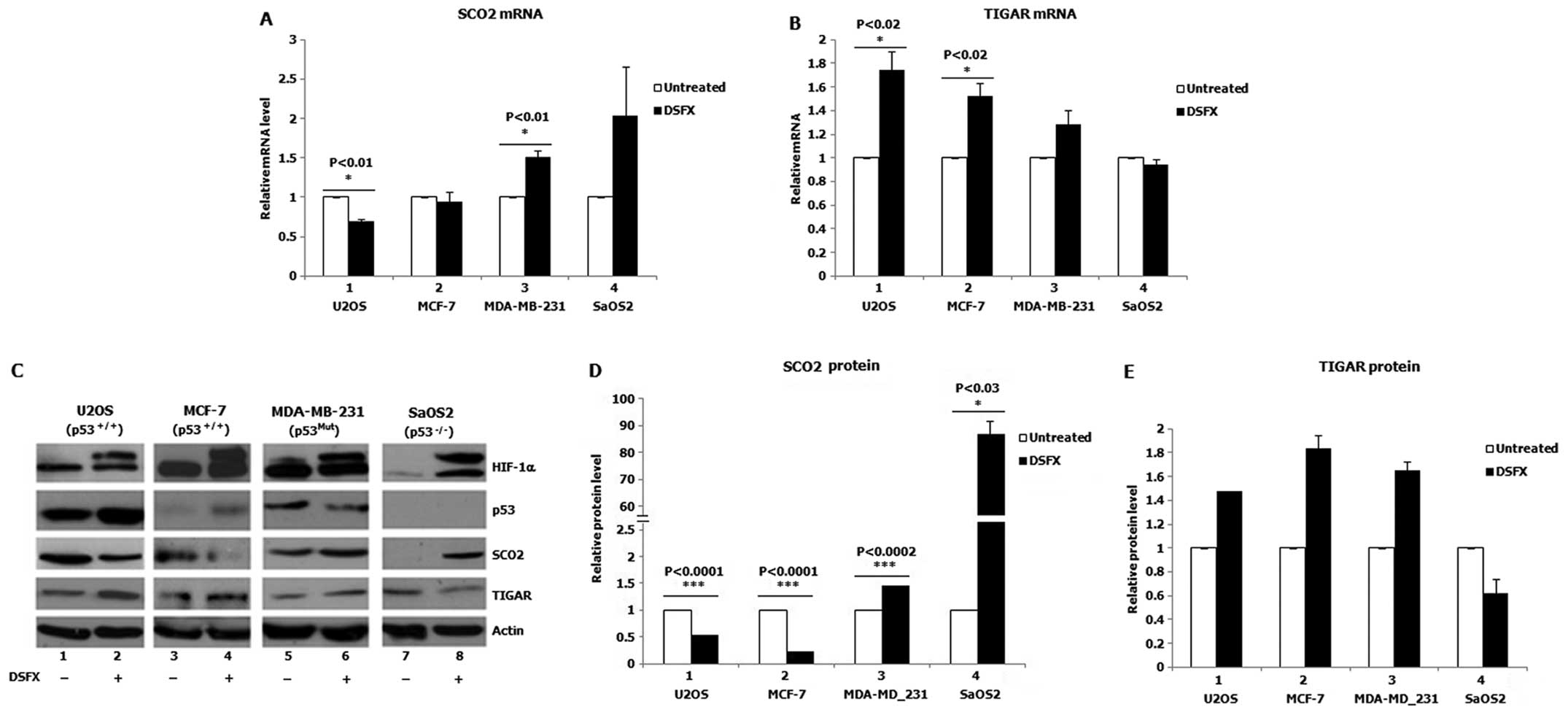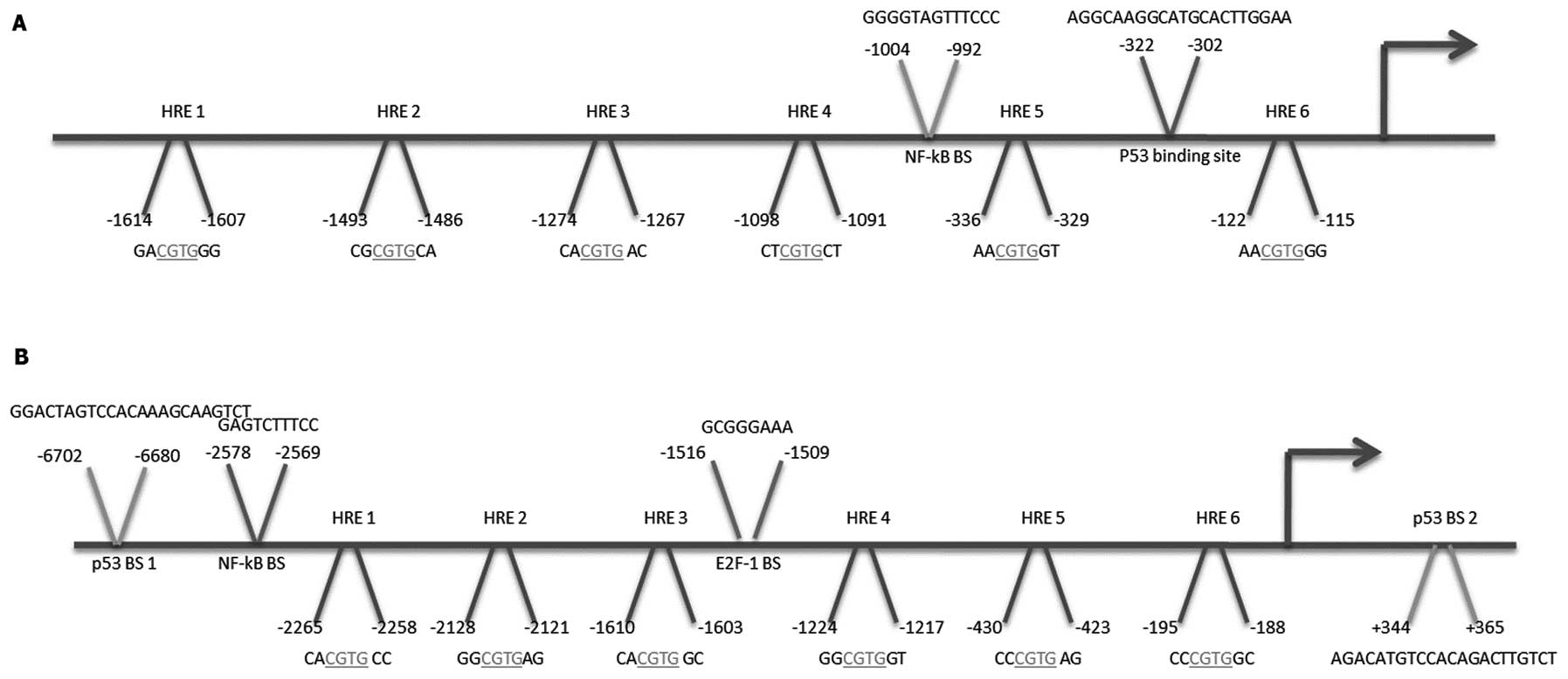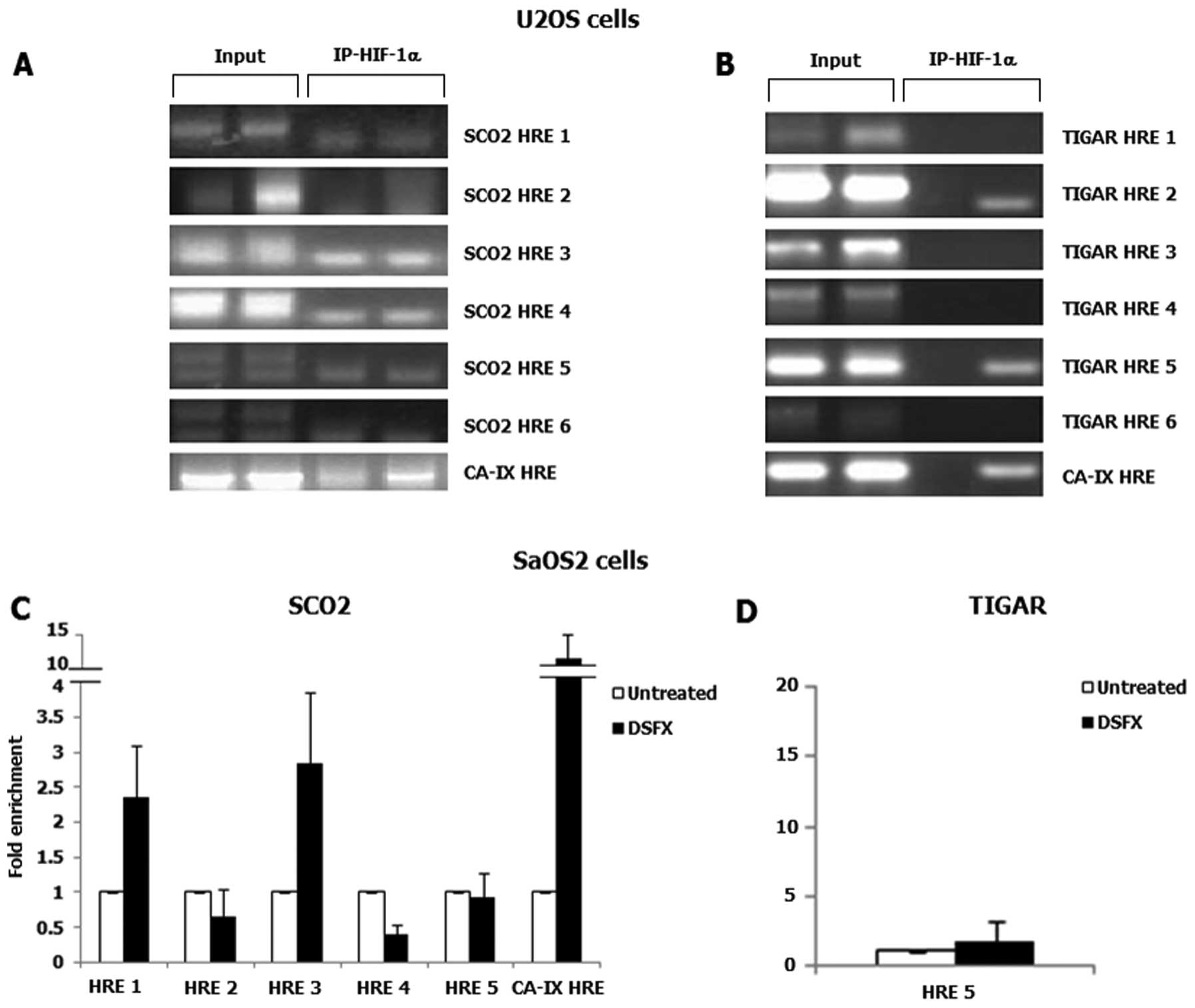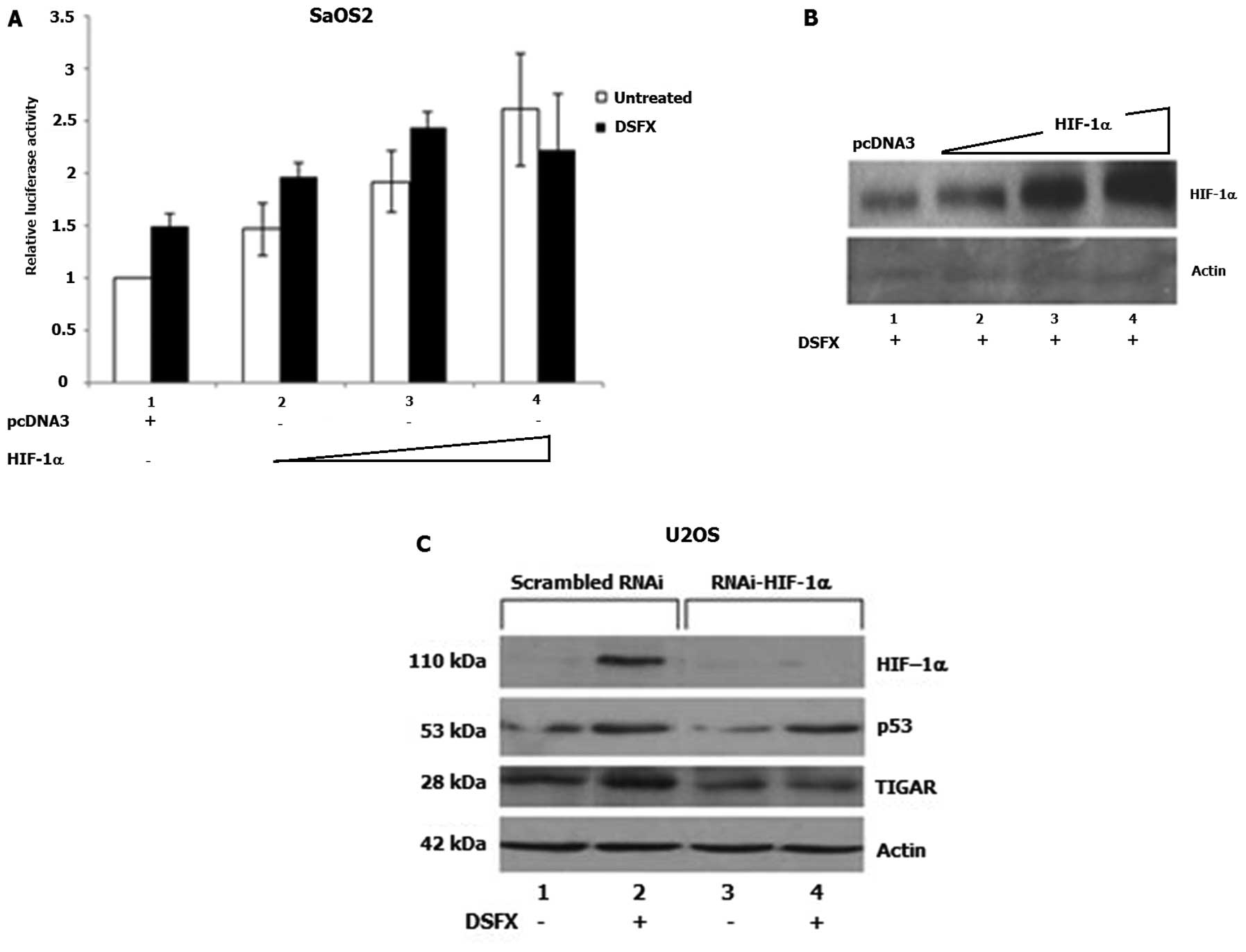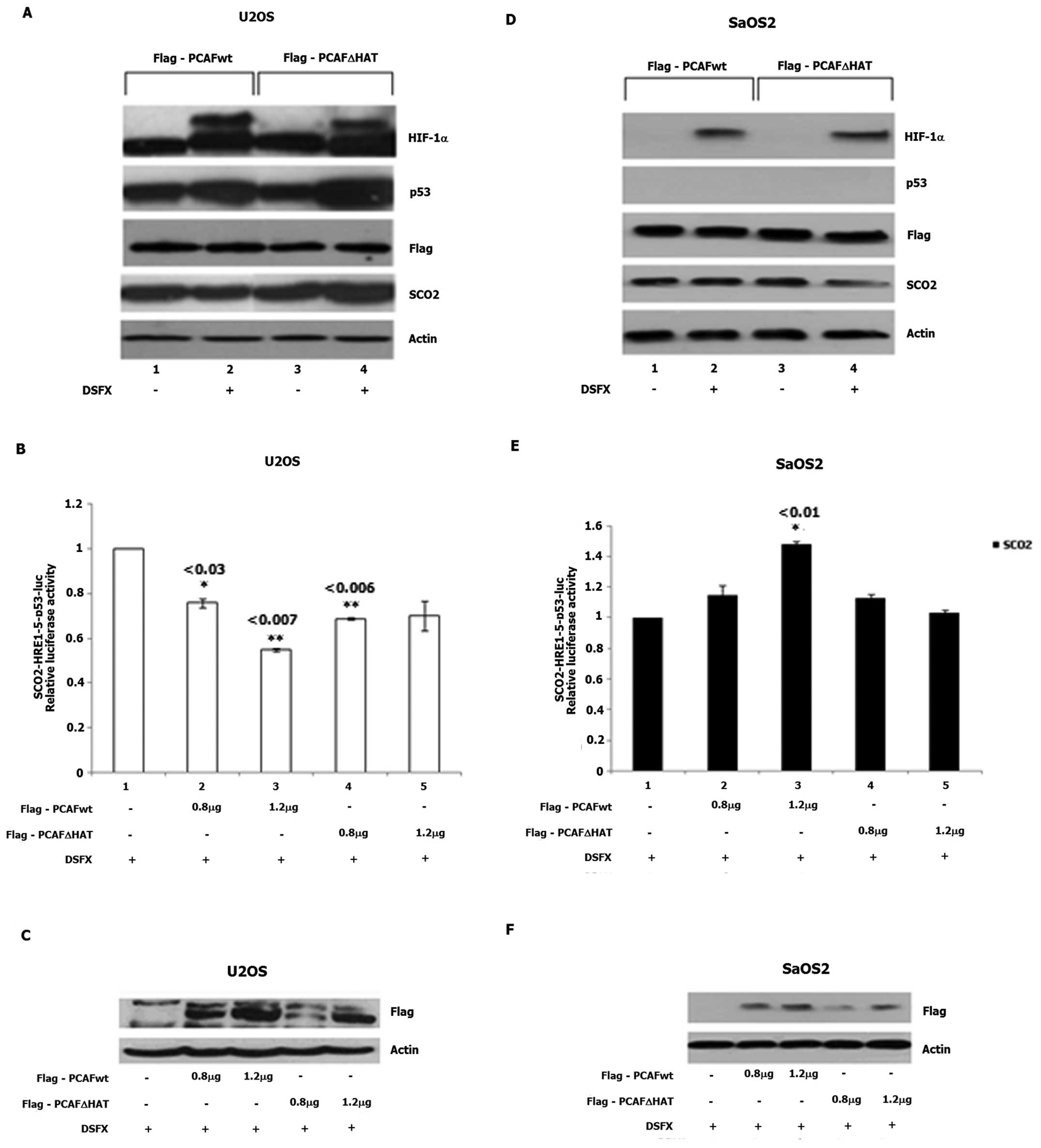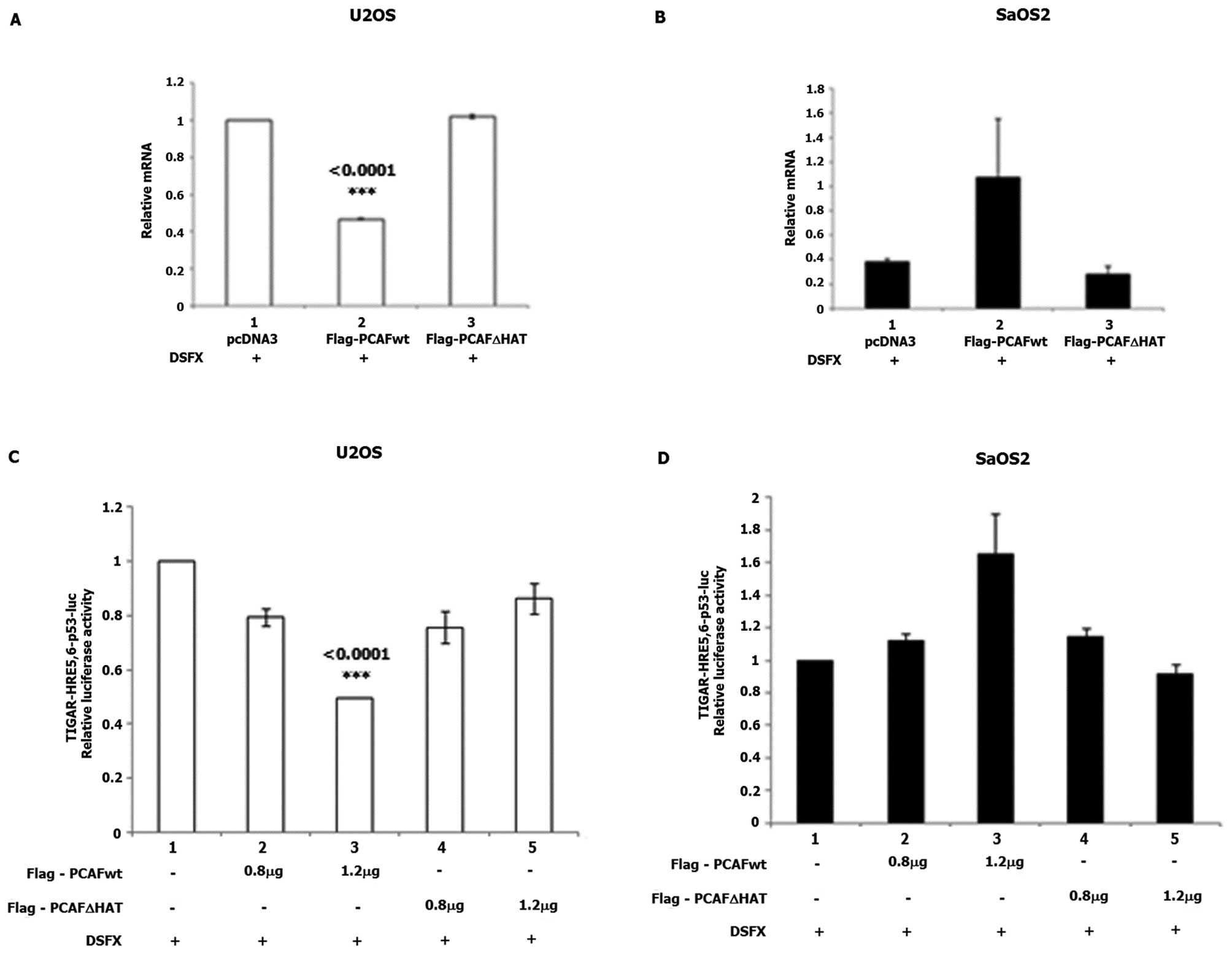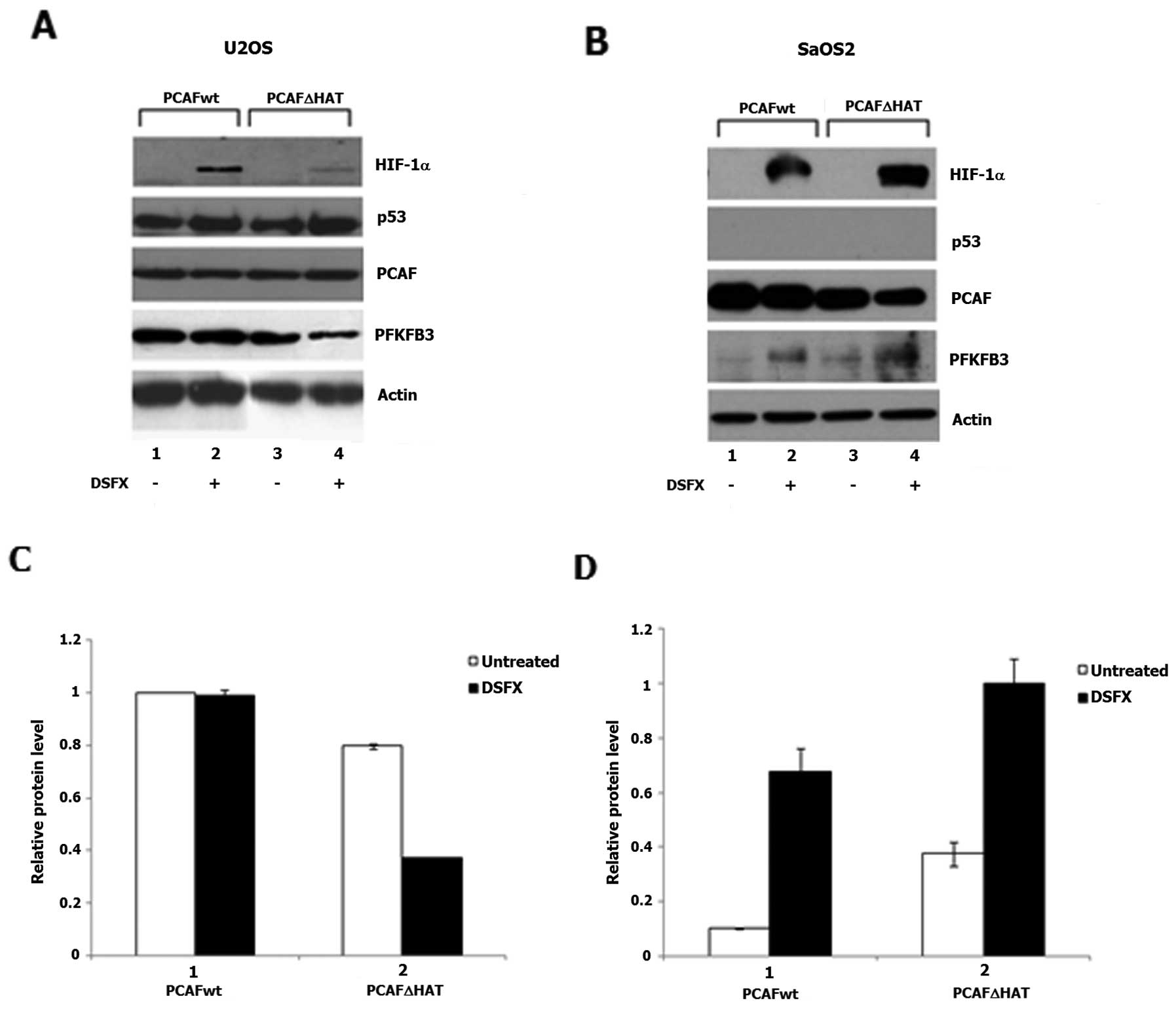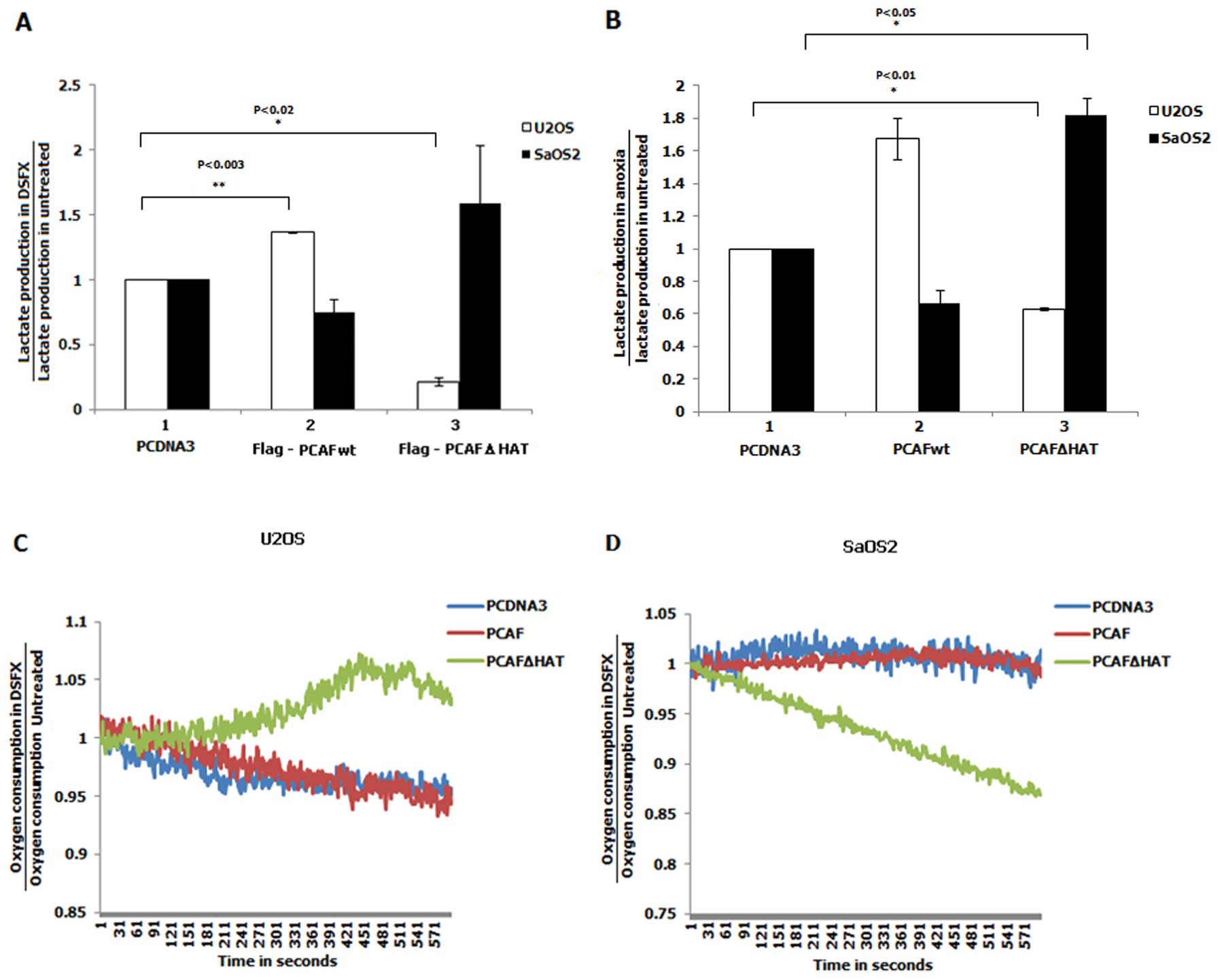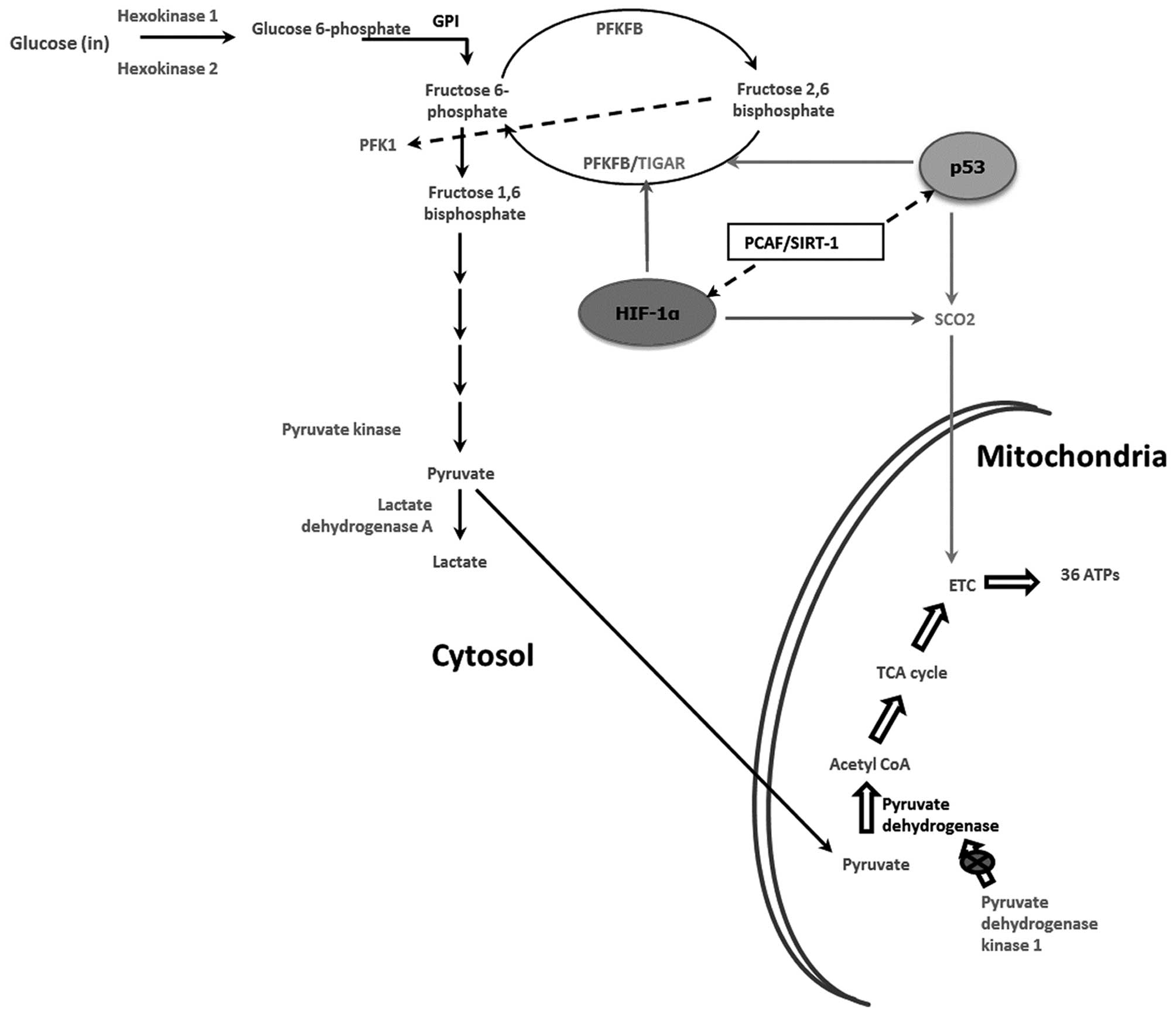Acetylation mediated by the p300/CBP-associated factor determines cellular energy metabolic pathways in cancer
- Authors:
- Published online on: April 17, 2013 https://doi.org/10.3892/ijo.2013.1907
- Pages: 1961-1972
Abstract
Introduction
It is well established that unlike normal tissues cancer cells switch the pathway of energy production from oxidative phosphorylation (OXPHOS) to aerobic glycolysis under normoxic conditions (Warburg effect) even though the efficiency of ATP production through OXPHOS is much higher than that of glycolysis (1,2). The high demand of rapid energy release in fast proliferating cancer cells is covered more efficiently by glycolysis, since this pathway can be regulated effectively without requiring the replenishment of suitable metabolites as is the case with the aerobic respiration which is a slower process. In addition, glycolysis confers the ability to cancer cells to evade apoptosis, resist immune responses and use the glycolytic intermediate products as substrates for anabolic reactions, explaining the preference of these cells to produce energy through glycolysis (3–5).
Cellular energy needs are covered by the coordination of the gene expression of a network of metabolic genes carried out by oncogene and tumour suppressor pathways coupling environmental conditions to cellular physiology. For example, in conditions of low oxygen concentration, which is a common event in the tumour microenvironment, HIF-1, the major orchestrator of transcription under these conditions, induces gene expression of glycolytic enzymes and reduces mitochondrial activity switching the energy production pathway from oxidative phosphorylation to glycolysis thus facilitating the cellular adaptation to hypoxia (6–8).
The p53 tumour suppressor on the other hand, displays diverse effects on energy metabolism by fine tuning the gene expression of proteins involved in both OXPHOS and glycolysis (9,10). Recently synthesis of cytochrome c oxidase 2 (SCO2) and TP53-induced glycolysis and apoptosis regulator (TIGAR), two genes involved in oxidative phosphorylation and glycolysis respectively, have been documented as p53 transcriptional targets (11,12). SCO2 is involved in the assembly of the cytochrome c oxidase complex (complex IV subunit 2) in the mitochondrial respiratory electron transport chain and the delivery of copper to this complex (13). Mutations in SCO2 gene severely impair cytochrome c oxidase assembly accompanied by cellular copper deficiency which result in various mitochondrial diseases such as encephalomyopathy and hypertrophic cardiomyopathy (14). By inducing SCO2 gene expression, p53 enhances mitochondrial respiration (9,10) while in its absence glycolysis prevails (11). TIGAR inhibits glycolysis as it displays homology to the phosphatase domain of the 6-phosphofructo-2-kinase/fructose-2,6-bisphosphatase (PFK2/FBPase2) enzyme which restrains glycolysis by dephosphorylating fructose-2,6-bisphosphate (F2,6BP). The kinase domain of the PFK2/FBPase2 induces the phosphorylation of fructose 6-phosphate (F6P) thereby increasing the intracellular levels of the F2,6BP, whereas the phosphatase domain of this bi-functional enzyme dephosphorylates F2,6BP to F6P. F2,6BP is an allosteric activator of PFK-1 therefore its levels play a crucial role in the determination of the glycolytic rate, the blockade of the Warburg effect and the redirection of glycolysis to the pentose phosphate pathway (PPP) (3,15,16). Induction of TIGAR gene expression is an alternative way by which p53 determines the cellular fate by depleting the intracellular NADPH hence mediating antioxidant defence (3,12).
We have previously demonstrated the role of the p300/CBP associated factor (PCAF) as common coregulator of the function of p53 and HIF-1α in hypoxia indicating that the acetylation function of PCAF is crucial in determining cell cycle arrest and survival or apoptosis in hypoxic conditions in a manner depending on its intrinsic HAT activity (17). PCAF mediated acetylation and Sirt-1 dependent deacetylation of HIF-1α have been more recently shown to modulate cellular responses in hypoxia (18). Taking into account the fact that both PCAF and p300 interact with Sirt-1 (19,20) and Sirt-1 is a well-known cellular sensor of reduced glucose and NAD+ availability (21), we hypothesised that PCAF as common regulator of p53 and HIF-1α, might coordinate the pathways for cellular energy production regulating the physiologically distinct pathways of OXPHOS and glycolysis.
It is known that p53 and HIF-1α play important roles in the determination of sensitivity/resistance of cancer cells to chemotherapy or radiotherapy (22). In this respect, p53 degradation, or HIF-1α stabilisation and fine tuning of their transcription target selectivity contribute to the response to radiation damage and affect the therapeutic efficacy of agents that regulate these properties. It is therefore of crucial importance to study the factors that can distinguish between the beneficial and detrimental properties of both these transcription factors in cancer therapy in order to improve the efficacy of various therapeutic approaches. We present herein evidence that the HAT activity of PCAF beyond its role in the control of cell proliferation and survival/apoptosis in hypoxic conditions (17) is also implicated in the modulation of metabolic pathways, such as OXPHOS or glycolysis regulating energy and oxidative stress homeostasis in cancer cells. This function of PCAF is in accord with the recently presented view suggesting the existence of common regulatory systems shared between cell cycle progression and metabolic pathways (23).
Materials and methods
Cell lines, cell culture and constructs
U2OS and MCF7 (p53 wt) and MDA-MB-231 (p53 mutant) and SaOS2 (p53−/−) cells were cultured in DMEM (Sigma-Aldrich, UK) supplemented with 10% v/v heat inactivated fetal calf serum (Gibco, UK) and 1% of penicillin and streptomycin 10,000 U/ml (Lonza, USA) at 37°C in a humidified atmosphere containing 5% CO2. Wherever mentioned, cells were treated with 250 μM desferrioxamine (DSFX) (Sigma-Aldrich) for 16 h.
The PCDNA3-Flag-TIGAR expression construct was a generous gift from Professor K. Vousden (Beatson Institute, Glasgow, UK) the PCDNA3-SCO2 expression construct was provided by Professor P. Hwang (NIH, Bethesda, MD, USA) and the pCiFlag-PCAF(wt) and pCiFlag-PCAF(ΔHAT) were obtained from Dr I. Talianidis (Athens, Greece) (24). Human SCO2 and TIGAR luciferase reporters containing the consensus HREs and p53 binding sites were constructed by amplifying the −287 to −1712 fragment of the SCO2 and the +400 to −508 region of the TIGAR (counted from the translation initiation codon) (primer sequences are shown in Table I) and inserting them in the pGL3 promoter luciferase vector (Promega, USA). The calcium phosphate method (25) and the polyfect transfection system (Qiagen, UK) were used to transfect cells. Luciferase reporter assays were carried out as described previously (25).
Immunoblotting and antibodies
Cells were harvested in 240 mM TNN buffer (50 mM Tris-HCl pH 7.4, 240 mM NaCl, 5 mM EDTA and 0.5% NP-40) and equal amounts of protein were loaded and resolved by SDS-PAGE and western blotting. After incubating with primary and secondary antibodies, the blots were developed with ECL substrate according to the manufacturer’s instructions (Pierce, Thermo Scientific, USA). The following antibodies were used for western blotting: β-actin (Abcam, UK), SCO2 (ProSciInc., USA), TIGAR-IN1 (ProSci Inc.), HIF-1α (H1α67; Calbiochem, EMD Chemicals, USA), p53 (DO1; Santa Cruz Biotechnology, USA), PCAF (E-8; Santa Cruz Biotechnology), anti-Flag (M2; Sigma-Aldrich) and PFKFB3 (Abgent, USA).
Quantitative RT-PCR
Quantitative RT-PCR analysis was carried out as described previously (17). Briefly, total RNA was extracted from cells using RNeasy plus mini kit (Qiagen, USA) following the manufacturer’s instructions. The RNA was then reverse transcribed to cDNA and used for qPCR analysis using SYBR Green fluorescent probe. Analysis was performed using the Opticon Monitor (Bio-Rad Laboratories, USA) or Realplex (Eppendorf, UK) software. The primer sequences used in qPCR reaction are provided in Table II.
Chromatin immunoprecipitation
Chromatin immunoprecipitation analysis was performed in U2OS cells as described previously (17). Briefly, chromatin was cross-linked using 1% formaldehyde and the protein DNA complex was sonicated to produce ∼500 bp DNA fragments which were then immunoprecipitated with HIF-1α-ChIP grade (AB2185; Abcam) or an irrelevant antibody (HRP conjugated anti-rabbit). The reverse cross-linked DNA fragments were then amplified in PCR reactions with specific primers (Table III) flanking different HREs within the TIGAR and SCO2 promoter and analyzed using Opticon Monitor software (Bio-Rad Laboratories) or 2% agarose gel electrophoresis.
Measurement of oxygen consumption
A Clark-type oxygen electrode system (Rank Brothers, Cambridge, UK) was used to measure the ability of the cells to uptake oxygen. The Clarke type electrode uses polarising voltage to create a current or flow of electrons between one silver and one platinum electrode. The output of the electrode is connected to a voltage adaptor and the output of this adaptor is connected to a Pico Log recorder (Pico Technology Ltd., UK). As the oxygen concentration in the incubation chamber changes, the current flowing between the two metal electrodes changes in proportion of the oxygen concentration in the incubation chamber. These changes in the current are converted to changes in the voltage which was recorded in the Pico Log recorder. Cells (2×105) were collected in 2-ml medium loaded into the incubation chamber maintained at 37°C and stirred continuously using a magnetic stirrer. The value of the voltage indicating the amount of oxygen available in the incubation chamber at each time-point in DSFX-treated cells was divided with the respective value obtained for the amount of oxygen available in the chamber in untreated cells. The inverted numbers attained from this calculation showing the oxygen consumption in treated and non-treated cells were plotted as a slope. Oxygen consumption was measured from 1 to 600 sec.
Measurement of lactic acid production
Cells were grown in 6-well plates, transiently transfected and treated as described in the text and figure legends. Lactate levels were quantified using Lactate Reagent kit (Trinity Biotech, Ireland) following the manufacturer’s instructions. Lactate production rates were expressed as nmol/min per milligram protein.
Results
SCO2 and TIGAR gene expression in hypoxia mimicking conditions
To investigate whether gene expression of the p53 transcription targets SCO2 and TIGAR was differentially affected in hypoxia mimicking conditions, we followed SCO2 and TIGAR mRNA and protein levels in p53wt (U2OS and MCF7), p53 mutated (MDA-MB-231), or p53-deficient (SaOS2) cells treated with the hypoxia mimicking agent DSFX. Significantly decreased SCO2 mRNA levels were observed in DSFX-treated U2OS cells (p53wt) compared to those in the non-treated cells (Fig. 1A, compare black bar 1 to white bar 1). In contrast, increased SCO2 mRNA levels were monitored in DSFX-treated MDA-MB-231 cells (mutated p53) and SaOS2 cells (p53 null) compared to those in non-treated cells (Fig. 1A, compare black bars 3 and 4 to white bars 3 and 4). Similarly lower SCO2 protein levels were detected in DSFX-treated versus non-treated U2OS and MCF-7 cells (Fig. 1C, compare lanes 2 to 1 and 4 to 3; Fig. 1D, compare black bars 1 and 2 to white bars 1 and 2) and higher in DSFX-treated as opposed to non-treated MDA-MB-231 and SaOS2 cells (Fig. 1C, compare lanes 6 to 5 and 8 to 7; Fig. 1D, compare black bars 3 and 4 to white bars 3 and 4).
In contrast to SCO2, increased TIGAR mRNA and protein levels were recorded in DSFX-treated U2OS and MCF-7 compared to non-treated cells (Fig. 1B, compare black bars 1 and 2 to white bars 1 and 2; Fig. 1C, compare lanes 2 to 1 and 4 to 3; Fig. 1E, compare black bars 1 and 2 to white bars 1 and 2). Although TIGAR mRNA levels did not change, downregulation of TIGAR protein was observed in DSFX-treated SaOS2 cells compared to non-treated cells (Fig. 1C, compare lanes 8 to 7; Fig. 1E, compare black bar 4 to white bar 4). Higher TIGAR mRNA and protein levels were documented in DSFX-treated MDA-MB-231 cells compared to those in non-treated cells (Fig. 1B, compare black bar 3 to white bar 3; Fig. 1C, compare lanes 6 to 5; Fig. 1E, compare black bar 3 to white bar 3). Taken together results presented in Fig. 1 are suggestive of a differential regulation of the SCO2 and TIGAR cellular levels in hypoxia mimicking conditions in a manner dependent on the presence of p53.
Putative HREs are present in the regulatory region of the SCO2 and TIGAR promoters
To gain a better understanding of the transcriptional events regulating SCO2 and TIGAR gene expression in DSFX-treated cells and in particular to test whether HIF-1 was involved in these events, the upstream regulatory region of the SCO2 and TIGAR promoters were submitted to bioinformatics analysis to investigate whether hypoxia responsive elements (HREs) were present in these regions. Putative HRE sites were identified within the regulatory region of both SCO2 and TIGAR promoters (Fig. 2).
The presence of binding sites for several transcription factors in addition to the known p53 binding sites (11,16) within the upstream regulatory region of SCO2 and TIGAR promoters implies that gene expression of these genes is under a complex control of multiple transcription factors. ChIP assays were carried out to assess the recruitment of HIF-1 to the putative binding sites identified in SCO2 and TIGAR promoters. HIF-1 complexes with chromatin were immunoprecipitated using HIF-1α specific ChIP grade antibody. Rabbit IgG was used as a negative control and 10% input as loading control. The known HIF-1 transcription target gene CA-IX was used as a positive control (Fig. 3A–C). In U2OS cells HIF-1α recruitment was not detected in any of the putative HREs identified within the SCO2 promoter (Fig. 3A), whereas only the HRE 5 within the TIGAR promoter was found to be occupied by HIF-1α in DSFX-treated U2OS cells (Fig. 3B, compare lanes 3 with 4; the band appearing in the TIGAR HRE 2 panel is not specific). However, in SaOS2 cells, HIF-1α was found to be recruited in the putative HRE 1 and HRE 3 sites within the SCO2 promoter (Fig. 3C). Furthermore, HIF-1α was not detected bound to the HRE 5 of the TIGAR promoter in the Saos2 cells (Fig. 3D).
To further investigate the involvement of HIF-1 in the transcriptional regulation of SCO2 gene expression, the fragment of the SCO2 promoter containing the putative HREs 1–5 (Fig. 2A) was cloned in the pGL3-Luc reporter vector as described in Materials and methods. The constructed SCO2-HRE1-5-p53bs-Luc was used to carry out luciferase reporter assays in DSFX-treated U2OS and SaOS2 cells ectopically expressing increasing amounts of HIF-1α. Results shown in Fig. 4A indicated that increasing amounts of HIF-1α (Fig. 4B) induced SCO2-HRE1-5-p53bs-Luc expression in SaOS2 cells signifying the potential involvement of HIF-1α in the regulation of SCO2 gene expression.
Possible involvement of HIF-1α in the regulation of TIGAR gene expression was evidenced in U2OS cells transfected with RNAi against HIF-1α and monitoring TIGAR protein levels (Fig. 4C). Increased TIGAR protein levels were observed in DSFX-treated U2OS cells transfected with scrambled RNAi compared to those detected in non-treated cells (Fig. 4C, compare lanes 2 to 1), whereas reduced TIGAR protein levels were recorded in U2OS cells transfected with RNAi-HIF (Fig. 4C, compare lanes 3 and 4 to lanes 1 and 2, respectively).
The HAT activity of PCAF is potentially involved in the determination of SCO2 and TIGAR cellular levels
We have previously reported that PCAF HAT activity plays important role in the determination of both p53 and HIF-1α transcription target selectivity in hypoxia mimicking conditions thus coordinating cell cycle arrest or apoptosis under these conditions (17). It is also known that lysine acetylases (such as p300 and PCAF) and deacetylases (such as Sirt-1) act antagonistically to promote or suppress the transcriptional activity of many transcription factors including p53 and HIF-1, thereby regulating important cellular functions (19,20).
Since SCO2 and TIGAR were identified as possible common transcription targets of p53 (11,16) and HIF-1α (Figs. 1–4) we were intrigued to examine whether the HAT activity of PCAF played coordinative role in selectively targeting p53 or HIF-1 to the SCO2 and TIGAR promoter in response to diverse environmental stimuli. For this purpose, SCO2 protein levels were followed in non-treated and DSFX-treated U2OS and SaOS2 cells transfected with either, Flag-PCAFwt or Flag-PCAFΔHAT expression vectors (Fig. 5). Reduced SCO2 protein levels were detected in DSFX-treated U2OS cells overexpressing Flag-PCAFwt compared to non-treated cells (Fig. 5A, compare lanes 2 to 1) while increased SCO2 protein levels were observed in DSFX-treated U2OS overexpressing Flag-PCAFΔHAT compared to the non-treated cells (Fig. 5A, compare lanes 4 to 3). In Flag-PCAFΔHAT overexpressing SaOS2 cells, reduced SCO2 protein levels were identified in DSFX-treated cells compared to the non-treated cells (Fig. 5D, compare lanes 4 to 3). No change in SCO2 protein levels was observed in Flag-PCAFwt overexpressing SaOS2 cells treated or not treated with DSFX (Fig. 5D, compare lanes 2 to 1).
Flag-PCAFwt overexpression in DSFX-treated U2OS cells downregulated luciferase expression driven by the SCO2-HRE1-5-p53bs-Luc reporter (Fig. 5B, compare bars 3 to 1). Increasing amounts of Flag-PCAFwt transfected in SaOS2 cells resulted in 1.5-fold increase in SCO2-HRE1-5-p53bs-Luc activity compared to that exhibited in the SaOS2 cells transfected with the empty vector (Fig. 5E, compare bars 1 to 3). No difference in the SCO2-HRE1-5-p53bs-Luc reporter activity was observed in U2OS and SaOS2 cells treated with DSFX and ectopically expressing increasing amounts of Flag-PCAFΔHAT (Fig. 5B and E, bars 4 and 5). Increasing expression of Flag-PCAFwt and Flag-PCAFΔHAT transfected in U2OS and SaOS2 cells is shown in Fig. 5C and F, respectively.
To test whether PCAF plays a role in the regulation of TIGAR gene expression, we followed TIGAR mRNA levels in DSFX-treated U2OS and SaOS2 cells transfected with Flag-PCAFwt or Flag-PCAFΔHAT expression vectors. A statistically significant reduction of TIGAR mRNA levels was observed in U2OS cells ectopically expressing Flag-PCAFwt (Fig. 6A, compare bars 2 to 1), whereas TIGAR mRNA levels were not affected in Flag-PCAFΔHAT-transfected cells (Fig. 6A compare bars 3 to 1). Upregulated TIGAR mRNA levels were detected in SaOS2 cells expressing Flag-PCAFwt (Fig. 6B, compare bars 2 to 1) and no effect of Flag-PCAFΔHAT (Fig. 6B, compare bars 3 to 1).
Flag-PCAFwt overexpression in DSFX-treated U2OS cells repressed the luciferase activity of the TIGAR-HRE5,6-p53bs-Luc reporter (Fig. 6C, compare bars 3 to 1). In DSFX-treated SaOS2 cells overexpression of Flag-PCAFwt induced the luciferase activity of the TIGAR-HRE5,6-p53bs-Luc reporter (Fig. 6D, compare bars 3 to 1). Flag-PCAFΔHAT overexpression did not affect the luciferase activity of the TIGAR-HRE5,6-p53bs-Luc reporter in either U2OS or SaOS2 cells (Fig. 6C and D respectively, bars 4 and 5). The increasing amounts of Flag-PCAFwt and Flag-PCAFΔHAT transfected in U2OS and SaOS2 cells are shown in Fig. 5C and F, respectively. Taken together the results shown in Figs. 5 and 6 support the notion that the HAT activity of PCAF regulates SCO2 and TIGAR cellular levels by fine tuning p53 and HIF-1α transcriptional activities and the interplay between these transcription factors (12,16,17).
To investigate whether PCAF played a role in the regulation of the expression of the HIF-1α transcriptional target gene PFKFB3 the protein levels of this glycolytic regulator were followed in U2OS and SaOS2 cells overexpressing either Flag-PCAFwt or Flag-PCAFΔHAT in the presence or absence of DSFX. Reduced PFKFB3 protein levels were observed in the Flag-PCAFΔHAT compared to Flag-PCAFwt overexpressing and DSFX-treated U2OS cells (Fig. 7A, compare lanes 4 to 2 and Fig. 7C, compare black bars 2 to 1). In SaOS2 cells the HAT activity of PCAF exhibited the opposite effect to that observed in U2OS on the PFKFB3 protein levels (Fig. 7B, compare lanes 4 to 2 and Fig. 7D, compare black bars 2 to 1).
Functional significance of the HAT activity of PCAF in the regulation of cellular energy metabolism
The functional significance of the regulation of SCO2 and TIGAR gene expression mediated by the acetyltransferase activity of PCAF was investigated by assessing the lactate levels produced by cells transfected with either Flag-PCAFwt or Flag-PCAFΔHAT. The lactate efflux observed in DSFX-treated cells was normalised to that produced by non-treated cells. Increased lactate production by DSFX-treated U2OS cells overexpressing Flag-PCAFwt was observed compared to that estimated in these cells expressing Flag-PCAFΔHAT under the same conditions (Fig. 8A, compare white bars 2 with 3). The opposite was the case in SaOS2 cells where overexpression of Flag-PCAFwt led to reduced lactate efflux in DSFX-treated versus non-treated cells whereas transfection of Flag-PCAFΔHAT resulted in increased production of lactate in hypoxia mimicking conditions (Fig. 8A, compare black bars 2 with 3). Lactate production measured in U2OS and SaOS2 cells incubated in an anoxic chamber presented similar results with those obtained from DSFX-treated cells (compare Fig. 8A with B). These findings indicated that the HAT activity of PCAF increased glycolysis in hypoxic U2OS cells and reduced it in SaOS2 cells corresponding with downregulated TIGAR gene expression in DSFX-treated and Flag-PCAFwt expressing U2OS cells and upregulated TIGAR gene expression in SaOS2 cells under these conditions (Fig. 6). Thus the differential lactate production in U2OS and SaOS2 cells could be mechanistically explained at least in part by the opposite effect of PCAF on the TIGAR gene expression in the two cell lines (Fig. 6).
Inability to produce energy through OXPHOS in cancer cells is compensated by increased glycolysis (26). Oxygen uptake is an indicator of the ability of the cells to produce energy through the OXPHOS pathway (11). The role of the HAT activity of PCAF in the regulation of OXPHOS was studied by quantifying the ability of Flag-PCAFwt, Flag-PCAFΔHAT or PCDNA3 empty vector transfected in U2OS or SaOS2 cells to uptake oxygen (Fig. 8C and D, red, green and blue lines respectively). The oxygen consumption in DSFX-treated and non-treated cells was calculated as described in Materials and methods. While the lactate production of DSFX-treated U2OS cells transfected with Flag-PCAFΔHAT was decreased compared to these cells transfected with Flag-PCAFwt under the same conditions (Fig. 8A, compare white bars 3 with 2), the oxygen consumption was found to be increased in the same conditions (Fig. 8C, compare green line with red and blue lines). In contrast to U2OS cells, DSFX-treated SaOS2 cells overexpressing Flag-PCAFΔHAT consumed less oxygen compared to cells transfected with Flag-PCAFwt (Fig. 8D, compare green line with red and blue lines). Taken together results shown in Fig. 8 indicate that the HAT activity of PCAF plays an important role in determining the pathway of cellular energy production in hypoxia mimicking conditions.
Discussion
Proliferation status and physiological conditions are some of the factors determining the cellular energy demands. Among the transcription factors that orchestrate the pathways of cellular energy metabolism to harmonize cell cycle progression and energy metabolism with environmental physiological conditions is the tumour suppressor p53 (27). Inactivation of p53 results in substantial OXPHOS deficiency (11) and increased dependence on glycolysis accompanied by elevated lactate production (28). The p53 mediated switch from OXPHOS to glycolysis is in part implemented by the transcriptional regulation of the expression of a number of genes involved in both OXPHOS and glycolysis by this transcription factor (11). For example, p53 acting in a cell type-dependent mode stimulates the expression of genes essential for the completion of the OXPHOS pathway such as SCO2(11) and inhibits glycolysis by repressing the glucose transporters GLUT-1 and GLUT-4 (29).
In cancer tissues the deprivation of cellular oxygen within hypoxic regions contributes to the shift to glycolysis and eventually tumour cell growth. In response to low oxygen concentration the gene expression of a variety of metabolic enzymes such as GLUT and the regulatory bifunctional PFKFB3 enzyme is directed by the HIF family of transcription factors (30,31). Dramatic increase of the ratio of kinase:phosphatase activity of the HIF-1α transcription target PFKFB3 in hypoxic conditions results in increased F2,6BP concentration in hypoxic solid tumours (31,32). The homologue to the bisphosphatase domain of the PFK2/FBPase2 gene TIGAR has been identified as a p53 transcriptional target (16) suggesting that the reduction of the phosphatase activity of FBPase2 in hypoxia and increased glycolysis could be exaggerated as a result of active repression of TIGAR gene expression under these conditions. In addition, HIF-1α mediated downregulation of mitochondrial oxygen consumption and preservation of the Crabtree effect might be the result of differential modulation of SCO2 gene expression in hypoxia (6).
In order to identify p53 and HIF-1α common transcription target genes involved in energy production pathways we tested the possibility the gene expression of the known p53 targets SCO2 and TIGAR was under HIF-1α control. We followed the mRNA and protein levels of these genes in hypoxia mimicking conditions, which revealed that both SCO2 and TIGAR cellular levels were differentially regulated in normoxia compared to hypoxia mimicking conditions (Fig. 1). To find out whether HIF-1α was one of the factors involved in the regulation of SCO2 and TIGAR mRNA and protein levels we searched for the existence of potential HRE sites within the regulatory region of the promoters of both these genes (Fig. 2) and tested the activity of these sites employing luciferase reporter and chromatin immunoprecipitation assays, which supported the notion that SCO2 and TIGAR were under HIF-1 transcriptional control (Figs. 3 and 4).
PCAF has been shown to acetylate both HIF-1α and p53 and coordinate their selective recruitment to pro-survival or apoptotic genes such as p21 and BID thereby regulating cell cycle arrest and apoptosis in hypoxic conditions (17). Given the fact that cell cycle regulation and metabolism share common regulatory pathways (23) and PCAF is a co-factor regulating cell growth effects mediated by both p53 and HIF-1α (17), we expanded our studies to investigate whether PCAF was involved in the fine tuning of p53 and HIF-1α mediated effects on metabolism. Luciferase reporter assays pointed out that the HAT activity of PCAF was involved in the HIF-1α mediated regulation of the expression of SCO2 (Fig. 5) and TIGAR (Fig. 6) gene expression indicating a role of PCAF mediated acetylation as a major regulator for the determination of the pathway of cellular energy production in hypoxia mimicking conditions. Furthermore, downregulation of PFKFB3 in U2OS cells overexpressing Flag-PCAFΔHAT in hypoxia mimicking conditions and upregulation of this enzyme in SaOS2 under the same conditions (Fig. 7) implied that the HAT activity of PCAF regulated both TIGAR (Fig. 6) and PFKFB3 (Fig. 7) cellular levels. Given the fact that TIGAR shares structural and functional similarity with the phosphatase domain of PFKFB3, this result suggested that TIGAR might compensate for the lack of phosphatase activity of PFKFB in hypoxia mimicking conditions.
The interplay of the two main bioenergetic pathways OXPHOS and glycolysis mediated by the HAT activity of PCAF was investigated by analysing lactate production and oxygen consumption in cells overexpressing Flag-PCAFwt or Flag-PCAFΔHAT variants (Fig. 8). Results shown in Fig. 8A and B suggested that Flag-PCAFwt overexpressing U2OS cells depend more on glycolysis in hypoxia mimicking and anoxic conditions than untransfected or Flag-PCAFΔHAT expressing cells under the same conditions (Fig. 8A and B). In contrast, in hypoxia mimicking or anoxic conditions SaOS2 cells overexpressing Flag-PCAFwt exhibited higher lactate level production than those transfected with Flag-PCAFΔHAT (Fig. 8A and B). Increased ability of Flag-PCAFΔHAT overexpressing U2OS cells to uptake oxygen in hypoxia mimicking conditions (Fig. 8C) could be indicative of elevated capacity of these cells to produce energy through OXPHOS. In addition, the increased lactate production observed in U2OS cells overexpressing Flag-PCAFΔHAT comply with the reduced oxygen consumption observed in these cells (Fig. 8A, B and D). Reduced oxygen uptake could be an indication of reduced oxidative phosphorylation, but the increased oxygen consumption may or may not indicate increased OXPHOS (33).
Collectively, the results presented provide evidence to support a role for the HAT activity of PCAF, at least in part, in determining the pathway of cellular energy production in U2OS and SaOS2 cells by fine tuning the crosstalk between p53 and HIF-1α (Fig. 9).
Acknowledgements
We would like to thank Professor K. Vousden, Professor P.M. Hwang and Dr I. Talianidis for providing reagents used in this study.
References
|
Fantin VR, St-Pierre J and Leder P: Attenuation of LDH-A expression uncovers a link between glycolysis, mitochondrial physiology, and tumor maintenance. Cancer Cell. 9:425–434. 2006. View Article : Google Scholar : PubMed/NCBI | |
|
Vander Heiden MG, Plas DR, Rathmell JC, Fox CJ, Harris MH and Thompson CB: Growth factors can influence cell growth and survival through effects on glucose metabolism. Mol Cell Biol. 21:5899–5912. 2001.PubMed/NCBI | |
|
Olovnikov IA, Kravchenko JE and Chumakov PM: Homeostatic functions of the p53 tumor suppressor: Regulation of energy metabolism and antioxidant defense. Semin Cancer Biol. 19:32–41. 2009. View Article : Google Scholar | |
|
Sonveaux P, Végran F, Schroeder T, et al: Targeting lactate-fueled respiration selectively kills hypoxic tumor cells in mice. J Clin Invest. 118:3930–3942. 2008. | |
|
Kroemer G and Pouyssegur J: Tumor cell metabolism: cancer’s Achilles’ heel. Cancer Cell. 13:472–482. 2008. | |
|
Papandreou I, Cairns RA, Fontana L, Lim AL and Denko NC: HIF-1 mediates adaptation to hypoxia by actively downregulating mitochondrial oxygen consumption. Cell Metab. 3:187–197. 2006. View Article : Google Scholar : PubMed/NCBI | |
|
Semenza G: HIF-1 mediates the Warburg effect in clear cell renal carcinoma. J Bioenerg Biomembr. 39:231–234. 2007. View Article : Google Scholar : PubMed/NCBI | |
|
Tennant DA, Duran RV, Boulahbel H and Gottlieb E: Metabolic transformation in cancer. Carcinogenesis. 30:1269–1280. 2009. View Article : Google Scholar : PubMed/NCBI | |
|
Vousden KH and Ryan KM: p53 and metabolism. Nat Rev Cancer. 9:691–700. 2009. View Article : Google Scholar | |
|
Shen L, Sun X, Fu Z, Yang G, Li J and Yao L: The fundamental role of the p53 pathway in tumor metabolism and its implication in tumor therapy. Clin Cancer Res. 18:1561–1567. 2012. View Article : Google Scholar : PubMed/NCBI | |
|
Matoba S, Kang J-G, Patino WD, et al: p53 regulates mitochondrial respiration. Science. 312:1650–1653. 2006. View Article : Google Scholar : PubMed/NCBI | |
|
Bensaad K, Cheung EC and Vousden KH: Modulation of intracellular ROS levels by TIGAR controls autophagy. EMBO J. 28:3015–3026. 2009. View Article : Google Scholar : PubMed/NCBI | |
|
Stiburek L and Zeman J: Assembly factors and ATP-dependent proteases in cytochrome c oxidase biogenesis. Biochim Biophys Acta. 1797:1149–1158. 2010. View Article : Google Scholar : PubMed/NCBI | |
|
Jaksch M, Ogilvie I, Yao J, et al: Mutations in SCO2 are associated with a distinct form of hypertrophic cardiomyopathy and cytochrome c oxidase deficiency. Hum Mol Genet. 9:795–801. 2000. View Article : Google Scholar : PubMed/NCBI | |
|
Li H and Jogl G: Structural and biochemical studies of TIGAR (Tp53-induced glycolysis and apoptosis regulator). J Biol Chem. 284:1748–1754. 2009. View Article : Google Scholar : PubMed/NCBI | |
|
Bensaad K, Tsuruta A, Selak MA, et al: TIGAR, a p53-inducible regulator of glycolysis and apoptosis. Cell. 126:107–120. 2006. View Article : Google Scholar : PubMed/NCBI | |
|
Xenaki G, Ontikatze T, Rajendran R, et al: PCAF is an HIF-1[alpha] co-factor that regulates p53 transcriptional activity in hypoxia. Oncogene. 27:5785–5796. 2008. | |
|
Lim J-H, Lee Y-M, Chun Y-S, Chen J, Kim J-E and Park J-W: Sirtuin 1 modulates cellular responses to hypoxia by deacetylating hypoxia-inducible factor 1α. Mol Cell. 38:864–878. 2010.PubMed/NCBI | |
|
Fulco M, Schiltz RL, Iezzi S, et al: Sir2 regulates skeletal muscle differentiation as a potential sensor of the redox state. Mol Cell. 12:51–62. 2003. View Article : Google Scholar : PubMed/NCBI | |
|
Motta MC, Divecha N, Lemieux M, et al: Mammalian SIRT1 represses forkhead transcription factors. Cell. 116:551–563. 2004. View Article : Google Scholar : PubMed/NCBI | |
|
Haigis MC and Sinclair DA: Mammalian sirtuins: biological insights and disease relevance. Annu Rev Pathol. 5:253–295. 2010. View Article : Google Scholar : PubMed/NCBI | |
|
Sohda M, Ishikawa H, Masuda N, et al: Pretreatment evaluation of combined HIF-1α, p53 and p21 expression is a useful and sensitive indicator of response to radiation and chemotherapy in esophageal cancer. Int J Cancer. 110:838–844. 2004. | |
|
Fritz V and Fajas L: Metabolism and proliferation share common regulatory pathways in cancer cells. Oncogene. 29:4369–4377. 2010. View Article : Google Scholar : PubMed/NCBI | |
|
Soutoglou E, Katrakili N and Talianidis I: Acetylation regulates transcription factor activity at multiple levels. Mol Cell. 5:745–751. 2000. View Article : Google Scholar : PubMed/NCBI | |
|
Demonacos C, Krstic-Demonacos M and La Thangue NB: A TPR motif co-factor contributes to p300 activity in the p53 response. Mol Cell. 8:71–84. 2001. View Article : Google Scholar : PubMed/NCBI | |
|
Wallace DC: Bioenergetics, the origins of complexity, and the ascent of man. Proc Natl Acad Sci USA. 107:8947–8953. 2010. View Article : Google Scholar : PubMed/NCBI | |
|
Bensaad K and Vousden KH: p53: new roles in metabolism. Trends Cell Biol. 17:286–291. 2007. View Article : Google Scholar : PubMed/NCBI | |
|
Zhou S, Kachhap S and Singh KK: Mitochondrial impairment in p53-deficient human cancer cells. Mutagenesis. 18:287–292. 2003. View Article : Google Scholar : PubMed/NCBI | |
|
Schwartzenberg-Bar-Yoseph F, Armoni M and Karnieli E: The tumor suppressor p53 down-regulates glucose transporters GLUT1 and GLUT4 gene expression. Cancer Res. 64:2627–2633. 2004. View Article : Google Scholar : PubMed/NCBI | |
|
Formenti F, Constantin-Teodosiu D, Emmanuel Y, et al: Regulation of human metabolism by hypoxia-inducible factor. Proc Natl Acad Sci USA. 107:12722–12727. 2010. View Article : Google Scholar : PubMed/NCBI | |
|
Yalcin A, Telang S, Clem B and Chesney J: Regulation of glucose metabolism by 6-phosphofructo-2-kinase/fructose-2,6-bisphosphatases in cancer. Exp Mol Pathol. 86:174–179. 2009. View Article : Google Scholar : PubMed/NCBI | |
|
Chesney J: 6-phosphofructo-2-kinase/fructose-2,6-bisphosphatase and tumor cell glycolysis. Curr Opin Clin Nutr Metab Care. 9:535–539. 2006. View Article : Google Scholar : PubMed/NCBI | |
|
Seyfried T and Shelton L: Cancer as a metabolic disease. Nutr Metab. 7:72010. View Article : Google Scholar |



